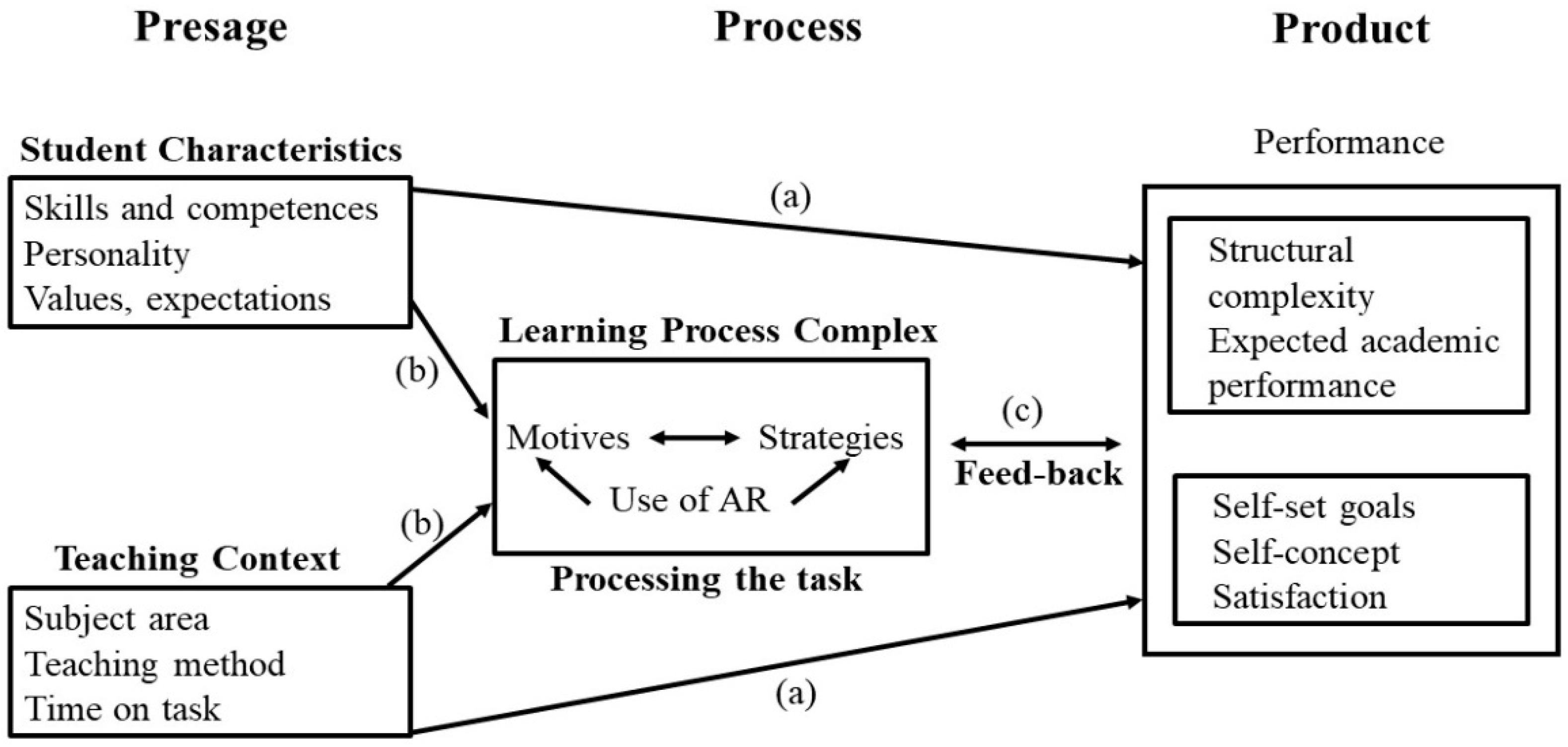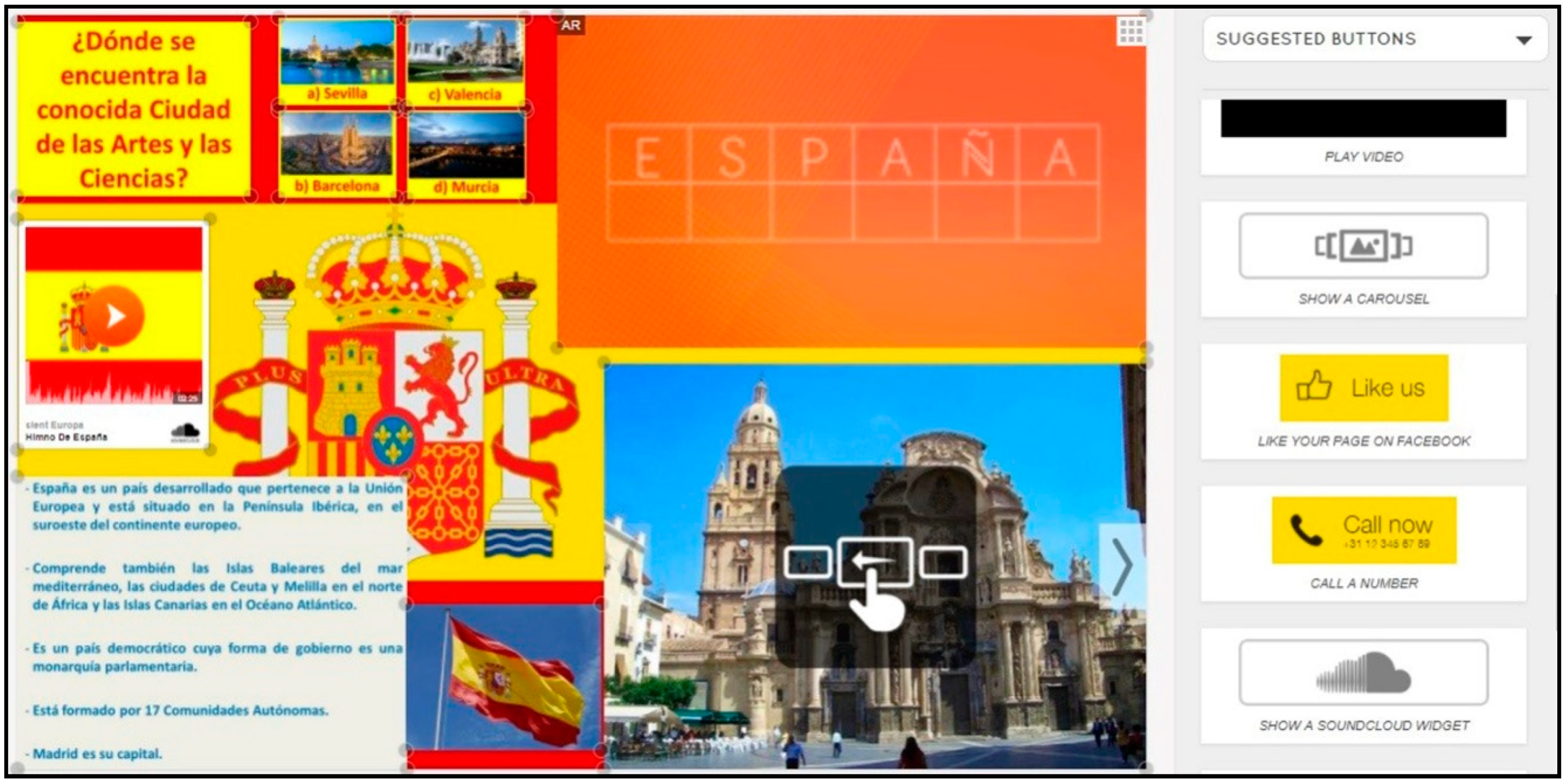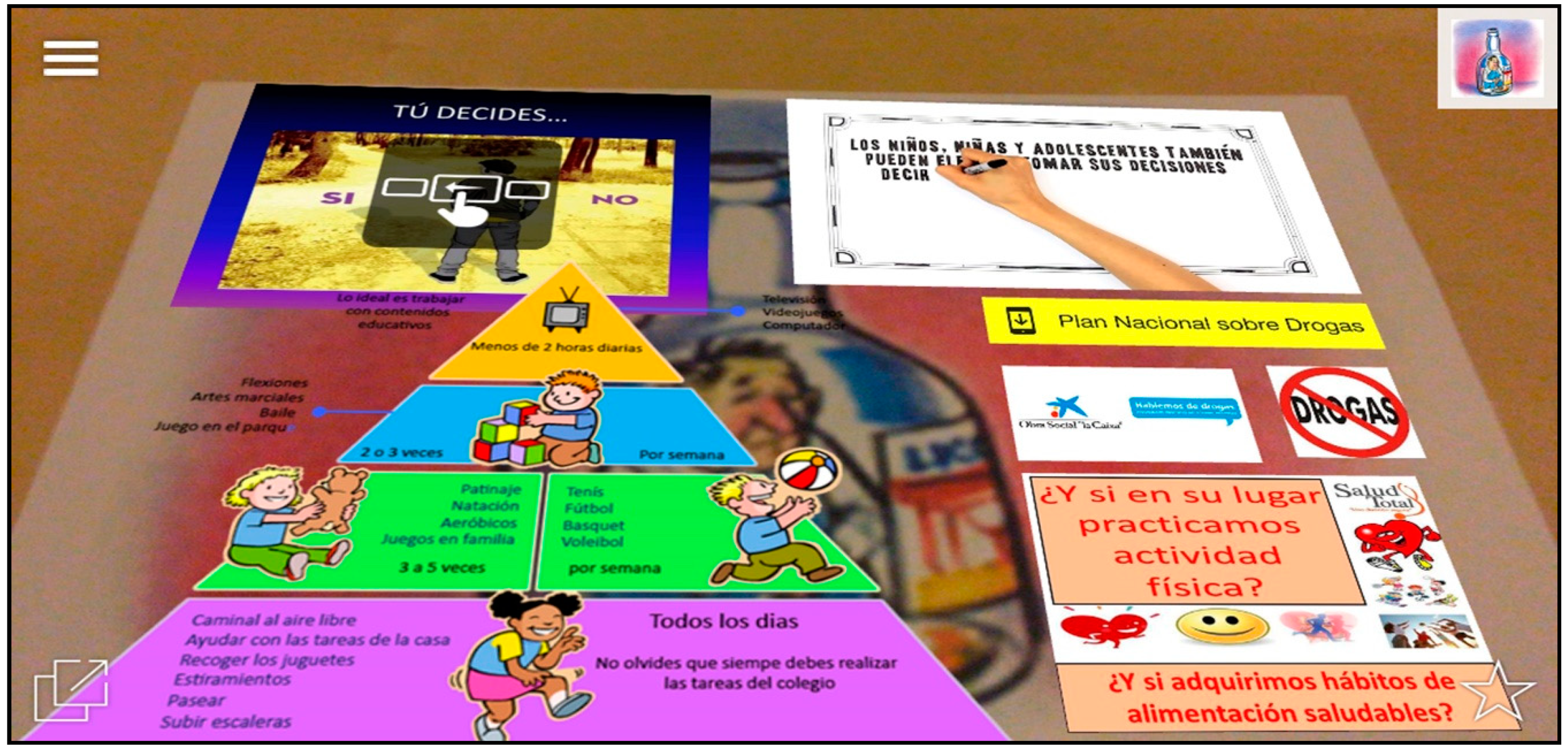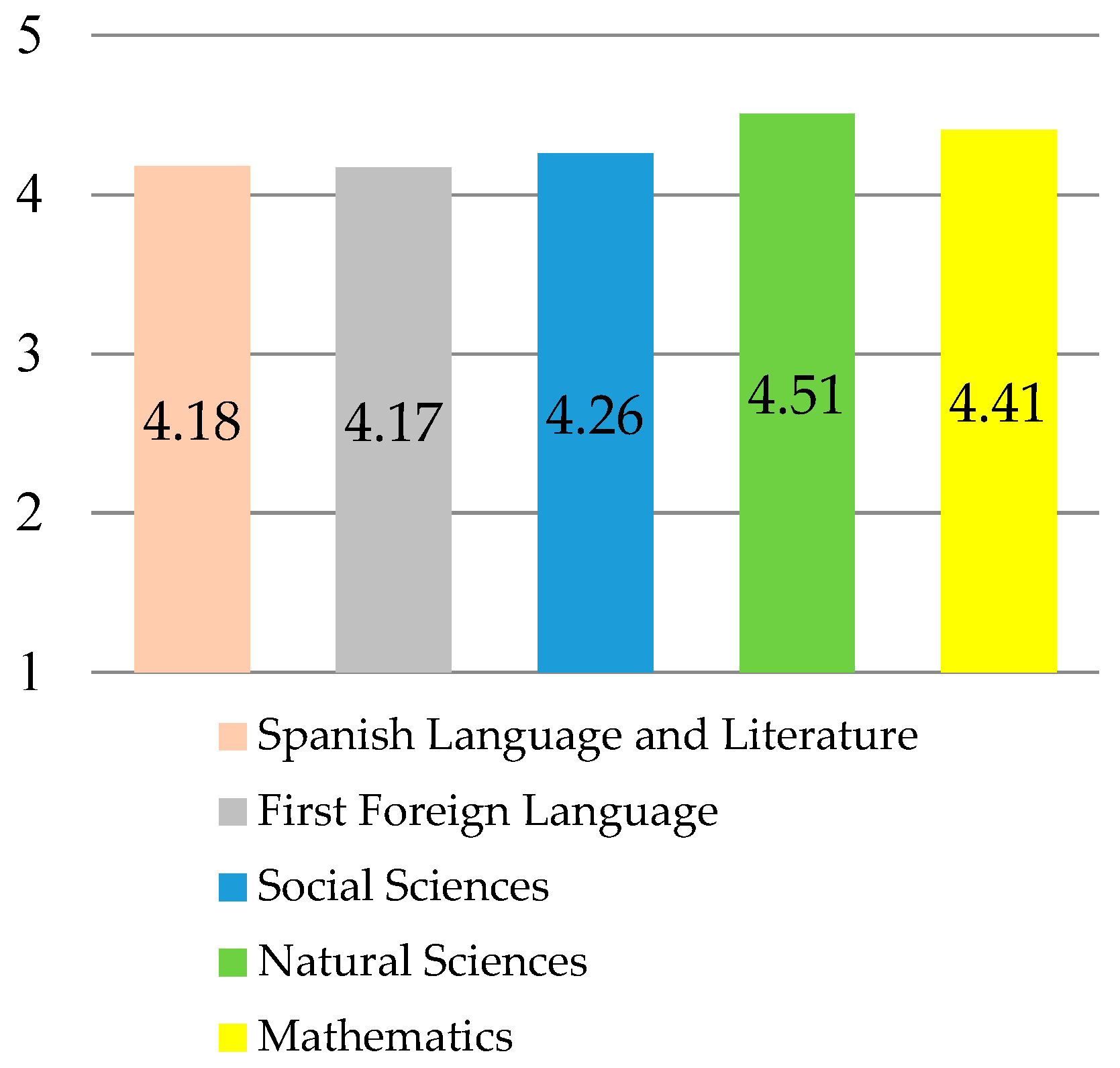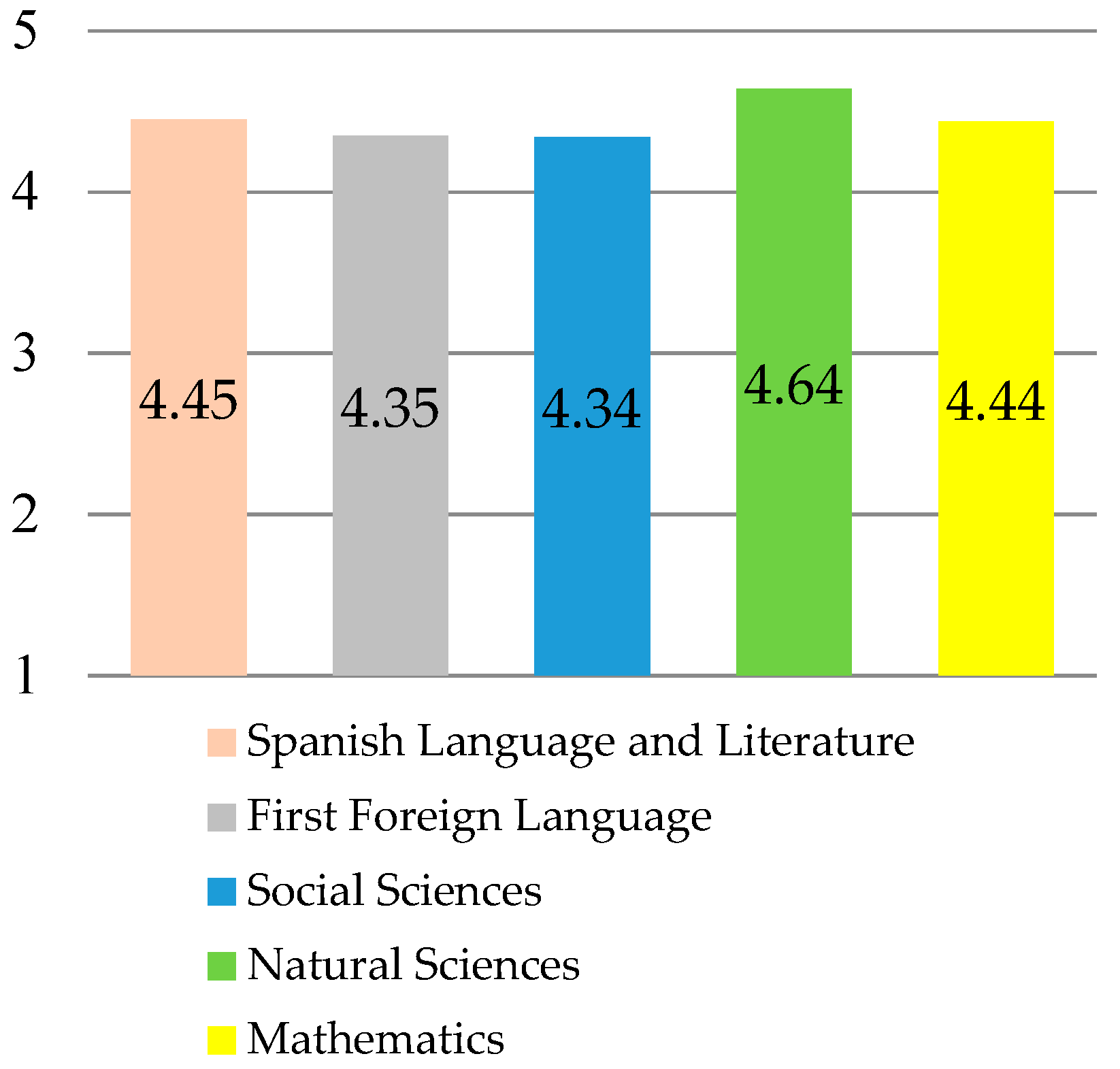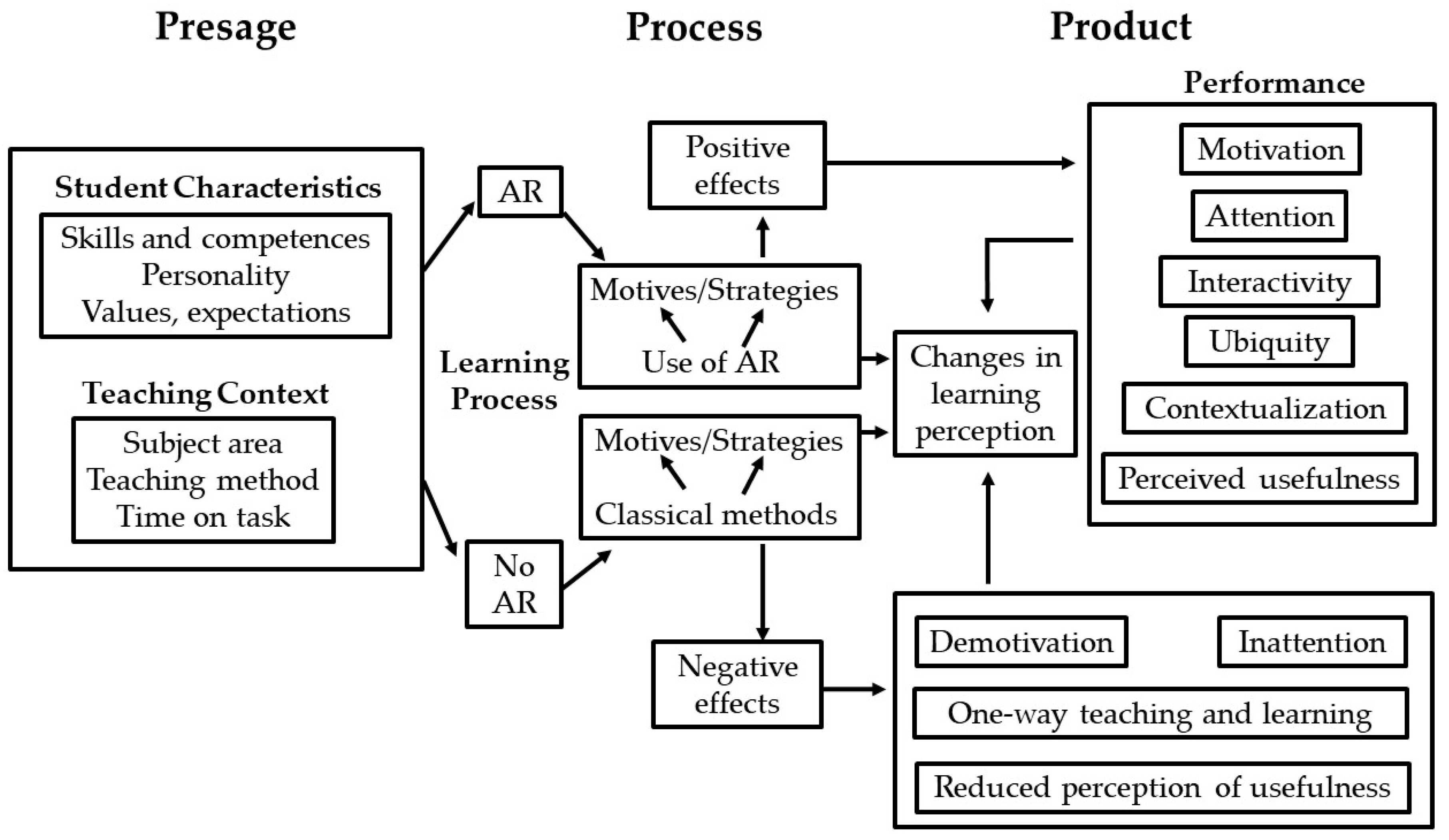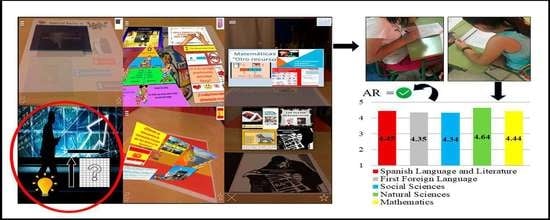1. Introduction
Education is at a stage where the ways of accessing information and knowledge are changing and evolving at a dizzying pace due to a series of developing technologies and pedagogies (gamification, cloud computing, learning in networks, flipped classroom, Massive Open Online Course-MOOC, etc.). The idea of using latest generation mobile devices in the classroom is gaining new ground. It has been demonstrated that mobile learning can enhance digital literacy skills and serve, among other benefits, as a strong contextual and institutional support which monitors students’ research as well as some aspects of their learning [
1,
2].
One of the main emerging concepts in this sector is augmented reality (AR). An argument supporting the growth of AR is the systematic review of Akçayır and Akçayır [
3], which analyzed 68 research papers from the Social Sciences Citation Index (SSCI). Their study found that the number of articles published on AR applied to education had increased exponentially in the last four years. An important question is how it is perceived as a technique that can enhance learning in the framework of various theoretical models and how an instructional design can be put into practice via a coherent methodology. This study attempts to answer these questions in depth in order to intensify awareness of AR and boost its development, showing how satisfaction, motivation and other positive variables are manifested in the participants in a noticeable way after its implementation.
1.1. Conceptualization and Terminology
Caudell and Mizell [
4], who coined the concept, define AR as a technology that enhances the user’s field of vision with the information necessary to perform a task, thanks to computational processes that can transform and chart simple graphics in real time. Milgram and Kishino [
5] add to this definition when they describe AR as any case in which a real environment is enhanced with virtual objects (computer graphics). Likewise, they present the term within a taxonomy (a virtuality continuum), in which all the possible types of viewing appear. Within this continuum, the real and virtual elements coexist in a single mixed reality space where AR is closer to the entirely real environment than to the entirely virtual environment. Another pioneer, Azuma [
6], sees AR as a variation of virtual environments which enables the user to see reality through superimposed objects.
It is noteworthy that some authors [
7,
8] have contradicted the idea of presenting AR conceptually as a technology in the strict sense, since it can be based on technology or understood as a resource that can accompany technology or draw from it, which means that it is necessary to interpret it beyond this exclusively classificatory treatment. Hence, one approach to this issue could be that AR is an emerging technique which is mediated by technology and which enables the superimposition of virtual information on a real environment, thus facilitating access to the borders of mixed reality, which can be two- or three-dimensional.
1.2. Educational Experiences and Evidence
The usability of AR environments has experienced a tremendous upsurge in education in recent years. In this vein, some authors [
3,
9,
10] have carried out systematic reviews in order to discover more about this technique, and the results point to AR being potentially able to support or enhance teaching and learning processes, concluding that its didactic use should grow in the coming years as there is an increase in the research, the expected technological developments and users’ knowledge.
More specifically, there are studies on games [
11,
12,
13], applications [
14,
15,
16] and illustrated books [
17,
18], which use AR to facilitate functionalities that allow teachers to establish new ways of showing relationships and connections for learning, incorporating image and video animations to the illustration of their texts.
In relation to the above, and starting from the construction of new learning processes, AR may be advantageous for formal learning since it allows students to interact with the real world and the digital world at the same time, and in that way creating new exciting and refreshing classroom situations in which to acquire knowledge. Indeed, it seems that this technique is widely accepted and improves academic outcomes [
19,
20].
Other studies have shown that AR can have a positive impact on motivation, attention and attitude [
9,
21], on conflict resolution and comprehension [
15,
22] and on learning efficiency and performance [
23,
24]. Positive results have also been obtained with regards to the use of this technique in the design and use of 3D video and image markers [
25] demonstrating that AR through markers is the most widely used version. Likewise, two areas that should be studied are the accessibility and usability of the learning experience [
9]. There is no doubt that to definitively implement AR in educational establishments this technique’s value for teaching and learning and its coexistence with other time-tested theoretical models and curricula must be demonstrated to and accepted by the educational community.
1.3. Learning Theories and Augmented Reality
In order to carry out experiences of this type in classrooms, a solid and consistent methodological approach is necessary with instructional design supported by accepted learning theories, which facilitate and justify the educational process itself.
During the review of the scientific literature, examples were identified among authors using AR to support implementing learning models and theories, such as the Situated Learning Theory [
12,
14,
15], Kolb’s Experiential Learning Theory [
23], or the Constructivist Theory [
12], among others.
Robust models that allow for the collection of relevant information on educational perception or satisfaction with regards to AR techniques also exist. To this effect, it is essential to adapt these theoretical principles to the educational process and to the product that will give us the information we desire. Some examples are, the Integrated Cognitive Affective Model of Learning with Multimedia (ICALM) by Plass and Kaplan [
26], the Attention, Relevance, Confidence, and Satisfaction (ARCS) model of motivational design by Keller [
27], which was developed in order to identify actions and approaches that would enable understanding the main motivational influences or solve problems about motivation for learning, following a systematic design process, and the Technology Acceptance Model (TAM) by Davis et al. [
28]. Indeed, the effect of AR on motivation and learning for all these models has been studied [
21,
23,
25].
Another possible area for studies about AR is the 3P learning model. Starting from the original model proposed by Dunkin and Bidle [
29], Biggs [
30] which adopts this approach, known as the 3P model, to describe and analyze the student body’s perspective and learning in a system composed of three basic components: Presage, Process and Product (3P). According to this model, these three factors interact with each other in a tendency toward equilibrium, which represents the proper functioning and success of the teaching and learning process [
30].
With all due caution, these theoretical models for learning provide methodological rigor and coherency to justify instructional design based on AR, taking all variables into account. As such, we believe it is necessary to increase the volume of investigation focused on these fields of study, raising diverse questions: What activities can be implemented in pre-adolescent stages to ensure students achieve a higher quality learning experience using AR? What are students’ perceptions about the real applications of using this technique? Is it possible to implement AR from a theoretical model which improves learning effectiveness and motivation? To answer these questions, the idea of designing and implementing a teaching environment based on AR and, later, analyzing the students’ degree of perception for this technique in primary education was conceived.
2. Materials and Methods
2.1. Aims of the Research
The overall aim is to evaluate how useful augmented reality is in improving the teaching and learning processes for sixth-grade students in primary education. This aim can be split into two specific goals:
To analyze the psychometric qualities of the questionnaire “Sixth-grade primary education students’ perception of the usefulness of augmented reality” (PEURA-E).
To evaluate the usefulness of augmented reality as a teaching and learning technique in the framework of the 3P model, according to each variable, both overall and by gender.
2.2. Design and Participants
To meet these objectives, a non-experimental, quantitative design study based on a survey was chosen. There were 106 participants from the sixth-grade of six primary schools in the Region of Murcia, an autonomous community of south-east Spain; 58 were boys and 48 were girls. Non-probabilistic convenience sampling was used to select the centers [
31]. In this regard, the following inclusion conditions or criteria were considered when selecting the participants:
Both students and their parents had to be aware of the study’s objectives and give prior informed consent.
All participants had to be aged between 11 and 12 years old.
More than 50% of the students selected needed to have a last generation mobile device.
Participants had to be registered on the AR platform and download the application on their mobile device at the start of the sessions.
2.3. Integration of the Attention, Relevance, Confidence, and Satisfaction (ARCS) Model into the Augmented Reality (AR)-Based 3P (Presage, Process and Product) Model
A basic assumption of this study is the idea of an instructional design based on the Presage-Process-Product (3P) learning model, adopted by Biggs [
30], with the addition of AR as a mediating element for learning. In this defining framework, everything related to the students’ characteristics and the teaching context are included in the presage stage. The student learning process and the connection between the strategies used by the students, their motivation to learn, and the use of AR are included in the process stage. The component which deals with satisfaction and expected academic performance, if the remainder of the conditions are met, is included in the product stage.
Figure 1 shows an adaptation of this model used to carry out our study.
Regarding the teaching and learning processes, Keller [
27] proposed that in every educational process it is essential to design an action plan that promotes student interest and attention while pointing out the relevancy of what has been learned, bestowing confidence in the achievement of learning objectives, and measuring satisfaction after overcoming the proposed challenges. This idea culminates in the ARCS model based on the categories of Attention, Relevance, Confidence and Satisfaction, as precursors to learning.
Consequently, this study intends to integrate the Keller ARCS model [
27], in the Process stage of the Biggs 3P model [
30]. To this end, a teaching proposal with activities based on AR was created following the ARCS model in order to understand the primary motivational influences in learning, in accordance with the four established categories.
This model is shown in
Table 1, with a description of the relationship among the different strategies employed throughout the teaching experience and the implicit motivational categories.
2.4. Teaching Proposal
A teaching proposal was designed and implemented in the framework of the described models that took into consideration Royal Decree 198/2014 of 5 September 2014, which establishes the primary education curriculum in the Autonomous Community of Murcia, under the provisions of the LOMCE, the Education Act in force in Spain since 2013. Five subject areas from the block of core subjects were selected and a 55-min learning session was prepared for each of them addressing the AR content; 15 min were allocated to the teaching process, 25 min to the activities and 15 min to allow the students to experiment and clear up any doubts. Some photographs of the research can be seen in the
supplementary document 1. As such, several interactive images were designed for each subject area. They included web links, images, audio tracks, videos and surveys about the described curricular contents so the information could be viewed on a mobile device or tablet through markerless or level image recognition.
We used the tool Layar Creator (version 7) [
34] to prepare these AR environments. This software allows users to design images and incorporate virtual layers in a variety of formats.
Figure 2 shows the process of creating an interactive image using the platform.
The teaching method for each session was based on showing the virtual information superimposed on the interactive images, as is shown in
Figure 3. The content was explained, and the motivational strategies used in the different categories of the ARCS model were emphasized with the goal of guiding the students throughout the learning process. Next, the students were tasked with interacting with the layers, and completing the activities, either individually or in groups.
Students were then given enough time to practice and create new images, autonomously, using the resources provided by the teaching staff and with the freedom to make their own models. Moreover, they were able to take the interactive images home or to the library and experiment with AR outside the school environment, researching and creating new proposals, on their own, using the resources from class and the contents taught, which are shown in
Table 2.
From this table, it becomes apparent that curricular contents are taught through a series of learning actions or activities which favor experimenting with AR. Most of the tasks are supported by academic web portals, web resources, content managers, blogs or activities whose origin is the manipulation of AR, whether using images, videos, and audio tracks or the use of touch-sensitive interactive surveys.
2.5. Data Collection Tool
Regarding information collection, the PEURA-E questionnaire (see the tool in the
supplementary document 2) whose language was adapted to the age and maturity of the participants was designed and validated to collect the data. The instrument contained 40 items classified in seven constructs: Teaching, Learning, Spanish Language and Literature, First Foreign Language, Social Science, Natural Sciences, and Mathematics. According to Krosnick and Presser [
35], this is a potentially large number of questions for sixth-grade students. For this reason, two control questions (items 33 and 39) were included in order to stand out when answering and prevent students from responding mechanically. However, the data from these two questions were not included in the final analysis so as not to alter the results of the research regarding perceived usefulness.
Regarding content, it is composed of closed-ended questions presented in the form of a Likert scale with five options, ranging from 1 (strongly disagree) to 5 (strongly agree), in addition to a nominal question at the beginning, to indicate gender. More specifically, the questionnaire contains several questions soliciting information for more than one dimension or aspect, called double-barreled questions [
36]. It should be noted that participants were advised that all the conditions of each item must be met for an answer to be given a positive rating, such that if the student felt any specific criterion was not met for the item, he or she was free to give the entire item a negative rating.
3. Results
3.1. Analysis and Description of Data
3.1.1. Aim 1
To address the first aim, the analysis of the psychometric properties of the PEURA-E questionnaire, the tool underwent a validation process. Three experts in AR validated the tool using an official rating scale designed by Serrano [
37]. This table appears in the
supplementary document 3. The content was validated by defining the items in the questionnaire according to relevant criteria related to the participants in the research and to their area of expertise. The scale was structured by organizing the items into 5 blocks (see
Table 3).
Table 4 shows the mean scores for the items in the scale and for each of the dimensions. Note that the scores range from 1 (strongly disagree) to 4 (strongly agree).
The experts’ evaluation was highly positive (see
supplementary document 4). Nevertheless, some modifications in the wording of certain items and in some aspects of the form were needed to obtain the final version. Regarding reliability, the questionnaire was analyzed to verify the internal consistency of the PEURA-E tool. The covariance of the items was measured with Cronbach’s alpha, which is commonly used in questionnaires that have a range of answers for each item [
31,
38]. Internal consistence was acceptable (α = 0.927). Finally, to evaluate the tool’s viability and identify any possible errors, a pilot study with a group of students of the same age and characteristics as the present study was carried out using the teaching approach and the questionnaire validated by experts. After the pilot study, which served as a trial run, only minimal modifications to the questionnaire were necessary.
3.1.2. Aim 2
To respond to objective 2, which referred to assessing the usefulness of AR as a teaching and learning technique in the framework of the 3P model, according to each variable, both overall and by gender, the students filled out the questionnaire individually and the data was organized by blocks or theoretical constructs with the goal of clarifying and organizing the results.
Table 5 shows the descriptive statistics for the overall perception students have of the usefulness of AR for the teachers’ teaching and for their own learning.
The perspective for the teaching construct reveals high values, with a mean score between 4.08 (Sd. = 0.957) and 4.50 (Sd. = 0.734) out of 5.00, and medians of 4.00 and 5.00 points for the four items. The most notable rating was for item 2, for which 61.3% of students selected the option strongly agree, and therefore consider that AR can complement teaching performed with books and notes.
For the learning construct the scores were slightly lower but still high, with the lowest rating being 3.97 (Sd. = 1.108) and the highest 4.25 (Sd. = 1.067). Item 6 stands out, with 83% of students responding agree or strongly agree, showing a firm majority in support of the idea that AR can improve students’ motivation. This was also the only item whose median was 5 points, while the others returned a value of 4.
As for the overall score for the usefulness of AR with respect to the curriculum,
Table 6 shows that there are two items in each area whose values were respectively the highest and the lowest, according to the proposed contents that were taught. We have had to select results due to spatial limitations, but all the items can be seen in the
supplementary document 5.
It can be seen that most of the items achieved mean scores of over 4.00 points, except for items 14 and 20, which were rated 3.99 (Sd. = 0.951) and 3.93 (Sd. = 1.106), respectively. The median was between 4.00 and 5.00 points for all the items. Also of note is the fact that in two of the five areas the items referring to the usefulness of learning these types of content with (items 16 and 34) received the maximum rating for their constructs (4.45; Sd. = 0.794 and 4.64; Sd. = 0.679, respectively). The highest percentages were in Social Sciences (item 23) and Natural Sciences (item 34), where strongly agree was over 70%. In contrast, strongly disagree was very low in all the areas with no item receiving over 5% and many at 0%.
Figure 4 offers the mean scores for the items in each area.
Figure 5 shows the mean values for the item that specifically measures the usefulness of AR in each area construct.
As
Figure 4 shows, Natural Sciences was the area with the highest construct mean (4.51), although it is notable that all the blocks were scored above 4.00 points. In the items in
Figure 5 we see Natural Sciences (item 34) has the highest mean score (4.64; Sd. = 0.679), which coincides with the highest construct mean, again for Natural Sciences.
Finally, the overall analysis of the results on the students’ perception of the useful AR according to the three constructs was repeated according to gender. We used the Kolmogorov–Smirnov test to make an exploratory analysis, which revealed that the distribution was not normal (p < 0.05). Backed by this normality test, we applied the non-parametric Mann–Whitney U test for two groups to compare whether opinions according to occupied equivalent positions.
For Teaching and Learning, females rated AR usefulness slightly higher than males in almost all the items. However, the curriculum constructs revealed differences in preferences depending on the item, although the overall opinion was highly positive for all the questions.
The analysis showed that in items 23 (p = 0.035) and 32 (p = 0.040), the distribution between genders varied, which allows us to state that there were significant differences in the responses (p < 0.05). Item 23 referred to whether AR can help students in studying the monuments of Spain as cultural heritage (Social Sciences), while item 32 asked whether AR helps in developing responsible behaviors in terms of healthy lifestyle, diet and proper functioning of the body (Natural Sciences). For the rest of the items there were no significant differences (p > 0.05).
4. Discussion
At the beginning of the article, we posed three questions: what activities could be implemented in pre-adolescent stages, so our students achieve higher quality learning using AR? What was the students’ perception of the real applications of using this technique? Moreover, is it possible to implement AR within the framework of a theoretical model that would improve the effectiveness and motivation to learn? We believe, according to objectives, all these questions have received a relevant response. This was due to the design of the study itself, which took all possible details into account in its articulation process, in planning activities designed for the subject areas, in its theoretical and practical justification by means of an adaptation of the 3P and ARCS models, through the use of motivational strategies, and with the greatest possible reliability and validity in data collection to attempt to assess the student body’s perceptions.
First, both the reliability and the validity study of the questionnaire content returned satisfactory results. Along these lines, the expert assessment and the pilot study provided ample assurance that the questionnaire complied with the proposed intervention model and the variables analyzed. Hence, the data collected in the questionnaire is suitable to respond to the research questions.
Secondly, after analyzing the students’ assessment of AR’s usefulness as a technique for teaching and learning within the framework of the 3P model in each construct overall and according to gender, the results were very positive for all constructs. Notwithstanding this, within each construct the assessment of some items were more notable than others.
The results from the teaching construct showed that AR can enable teaching to be undertaken as a discovery of contents where the teacher acts as a guide and allows knowledge acquisition to be adapted to the areas being taught. Specifically, the most promising results were found in item 2, which indicates that AR might provide another way, alongside books and notes, for the teacher to teach. One of the questions that now arises is whether AR will be able to provide short-term changes to teaching methodology, given that participants stated that one idea would be to alternate between traditional textbook teaching and notes and this new form of teaching.
From the analysis of the results for the learning construct, it appears that AR can heighten students’ attention and motivation, helps them to understand content better, increases classroom participation, promotes student collaboration and enhances the quality of learning and studying. However, even though all scores were high, the highest were obtained in the assessment referring to motivation and attention, coinciding with other studies mentioned [
9,
21]. Specifically, the study carried out by Di-Serio et al. [
21] also examined the ARCS model [
27], analyzing four motivational factors and concluded that the attention and satisfaction categories are rated higher using AR as a learning environment in comparison to other settings. In our study, the attention factor was considered to capture students’ interest in AR and stimulate their curiosity to learn, while the satisfaction category was used in completing the final questionnaire, resolving uncertainties, and proposing improvements.
Regarding the different areas of the core curriculum, the results were again interesting, especially for Natural Sciences, where the scores were highest for the use of AR for the content dealing with the prevention and consumption of drugs. It was also shown that this technique can be successful when teaching fractions in Mathematics as it facilitates their reading, interaction, comprehension and solution. Noteworthy results were also found in Social Sciences in the area of the country’s cultural and historical heritage and when studying the main European capitals. Lastly, in Spanish Language and Literature, AR was reported to produce improvements in digital interaction and manipulation by working with different types of text. There is no doubt that working this way fosters interactivity and immediacy to teaching and learning of standard curricular contents.
In terms of gender, as mentioned earlier, the perception of the usefulness of AR only varied significantly for two items (23 and 32). Elsewhere, the male score was higher in some items, while in others it was the female score, although differences were not significant. The results for these two items can be explained reasoning that the boys were more interested in the AR proposal addressing Social Science content, while the girls were more motivated by the study of behavior, healthy living practices, good eating routines and guidelines for body care, due to greater interest in this topic than the boys. Indeed, during the study the boys were observed showing greater interest than the girls in cultural heritage. They constantly interacted with their AR layers and asked about the origin and historical meaning of specific monuments, while the girls asked more questions about food, viewed AR layers about healthy living practices and searched the internet for more content on these topics.
In short, the objectives proposed received very positive responses, which encourages the idea that these educational practices are viable. There are many benefits that AR can bring to education, as it allows unknown areas to be explored, as well as fostering new dynamic and engaging ways of teaching and learning. In fact, the main justification of our study to show that the use of AR also enables teaching which is completely contextualized within the curricular content, drawing from a theoretical model that supports and improves the learning process. As Biggs et al., [
32] pointed out, student factors, the teaching context, the learning approaches used for the task, and expected outcomes or performance interact with each other forming a dynamic system that, if well defined, can favor new motivational strategies that enhance learning.
5. Limitations, Prospective and Practical Socio-Educational and Research Implications
Despite the optimistic findings, this research has been a subjective analysis of AR, so its real value in enhancing learning needs to be verified. We are aware that this requires more than just observations and opinions and should consider aspects regarding its real possibilities for implementation based on a controlled assessment of the learning that is going on. Moreover, this study does not collect information from all the variables involved within the theoretical models considered. Our intention is to supplement this investigation by studying the interaction of the presage, process, and product variables within the 3P model to see how they affect perceived acceptability and academic performance. At the same time, we must verify to what extent the motivational strategies adopted by a given student influence the student’s perception of these environments. To this end, categories are being designed and will soon be implemented within a qualitative approach. We also want to acknowledge limitations such as the lack of a comparison group or a focus group, which would have provided additional insights into the students’ experiences.
At practical, socio-educational and research levels, the findings provide a valid and reliable response to the objectives sought, and although future research should provide a more solid base, these results allow us to state that AR enjoys wide acceptance among primary school students and has a very relevant role to play in teaching and learning in the coming years. The development of this technique (higher levels of processing, sensors, etc.) will also affect its level of acceptance and use as a school resource, which will serve to demand that high-level politicians invest larger amounts of money and draw up new plans and projects to be implemented around this technique.
6. Conclusions
The Biggs 3P model and the Keller ARCS model have served to support our study and provide rigor, demonstrating that using AR as a mediating element can foster new learning strategies and that these affect motivational processes. However, for this to happen, baseline aspects such as the student’s characteristics and skills or other contextual factors such as the subject area taught, the method used, or the time devoted to the task must be considered. All of these factors impact the degree of perceived usefulness and expected performance, and is directly related to the level of participant interest. These contributions are shown in
Figure 6, through a flow chart that synthesizes the main conclusions of the paper.
Regarding teaching, this group of schoolchildren finds AR to be a more satisfying and enjoyable complementary approach to more traditional teaching materials. Most students are used to working with books, photocopies or notes, and any new learning format which differs from these materials is perceived as appealing, useful, and interesting to them. As such, they would like the teacher to teach them ways to discover new content on their own and to use alternative methods based on the use of touch screens, online resources, interactive surveys or experimentation with virtual resources to make such processes more dynamic [
39,
40].
As regards their own learning, the students highlighted an increase in motivation thanks to their being able to tackle contents using the AR technique. Clearly, AR motivates the students and allows them to acquire knowledge in a more dynamic, fun and interactive way. Consequently, the justification for using AR must be supported by the promotion of actions based on hands on learning, interactivity and research, which are backed by powerful theoretical models capable of developing competent students who know how to deal with future real-life situations.
Concerning curriculum, we contend that the use of AR for the core subjects is very efficient and practical, since it provides for a more contextualized and organized way of learning whereby, starting from a theoretical model, AR is the mediating element of knowledge. The fact that Natural Sciences was so highly rated may be due to the content, as the subject matter tackled aroused a lot of interest among the pre-adolescent students when they are beginning to acquire some notions of alcohol, drugs, relationships with others and decision making. In fact, the attention and interest shown by students made it possible to address the motivational strategies at greater depth with respect to the categories being taught (ARCS model) and the proposed activities.
There is no doubt that AR should be implemented as a standard approach in formal teaching. The main reason for its inclusion in teaching and learning processes stems from its innovative character, as well as the benefits derived from its interactive nature, ease of use, immediacy, and the motivation it induces.
AR implies direct involvement in students’ learning since students started to ask questions that highlighted their interests in knowing more about AR (What is it for? How do we use it? What materials should we use when working with it? How do I incorporate virtual layers?). Students found that learning with AR was something new and viable, and this would seem to be a clear invitation to professionals to think about other ways to teach and not just the traditional one.
Other advantages that AR point to in the short term include fostering better relations between teachers and students, more active and collaborative participation, better understanding and advances in the cohesion between teaching and methodological styles.
It is also important to highlight the key role that mobile AR plays in the environment, since it is an approach for both the classroom, with the guidance of teachers, and outside the school setting, as was witnessed when the students continued using AR outside of the classroom. The pervasiveness and flexibility that AR systems offer represent an improvement that should be taken advantage of in the educational sector to provide competence, commitment and stability to academic work.
Supplementary Materials
The following are available online at
https://www.mdpi.com/2076-3417/9/24/5426/s1, Supplementary document 1: Some photographs of the research, Supplementary document 2: Questionnaire PEURA-E, Supplementary document 3: Scale for experts to evaluate content, Supplementary document 4: Evaluation of the contents by experts, Supplementary document 5: Evaluation of the usefulness of AR by students.
Author Contributions
Conceptualization, A.L.-G.; methodology, J.M.; software, A.L.-G.; validation, A.L.-G; formal analysis, A.L.-G., J.M. and P.M.-M.; investigation, A.L.-G.; resources, P.M.-M., J.M. and A.L.-G.; data curation, A.L.-G.; writing—original draft preparation, A.L.-G.; writing—review and editing, P.M.-M., A.L.-G. and J.M.; visualization, P.M.-M. and A.L.-G.; supervision, P.M.-M.; project administration, P.M.-M.; funding acquisition, P.M.-M. All authors have read and approved the final version of the paper.
Funding
This research was funded by the “Spanish Ministry for Science, Innovation and Universities. Secretary of State for Universities, Research, Development and Innovation”, grant number PGC2018-094491-B-C33, “Spanish Ministry for Economy, Industry and Competitiveness and European Social Fund”, grant number EDU2015-65621-C3-2-R (BES-2016-078837), and “Seneca Foundation. Regional Agency for Science and Technology”, grant number 20874/PI/18. We would like to thank these bodies.
Acknowledgments
Our thanks to Stephen Hasler, John Meagher and Katy Mikes for their help in translating the paper.
Conflicts of Interest
The authors declare no conflict of interest.
References
- Christensen, R.; Knezek, G. Readiness for integrating mobile learning in the classroom: Challenges, preferences and possibilities. Comput. Hum. Behav. 2017, 76, 112–121. [Google Scholar] [CrossRef]
- Suárez, Á.; Specht, M.; Prinsen, F.; Kalz, M.; Ternier, S. A review of the types of mobile activities in mobile inquiry-based learning. Comput. Educ. 2018, 118, 38–55. [Google Scholar] [CrossRef]
- Akçayır, M.; Akçayır, G. Advantages and challenges associated with augmented reality for education: A systematic review of the literature. Educ. Res. Rev. 2017, 20, 1–11. [Google Scholar] [CrossRef]
- Caudell, T.P.; Mizell, D.W. Augmented Reality: An application of heads-up display technology to manual manufacturing processes. In Proceedings of the Twenty-Fifth Hawaii International Conference on System Sciences, Kauai, HI, USA, 7–10 January 1992; IEEE Computer Society: Washington, DC, USA, 1992; pp. 659–669. [Google Scholar] [CrossRef]
- Milgram, P.; Kishino, F. A taxonomy of mixed reality visual displays. IEICE Trans. Inf. Syst. 1994, 77, 1321–1329. [Google Scholar]
- Azuma, R. A survey of Augmented Reality. Presence Teleoperators Virtual Environ. 1997, 6, 355–385. [Google Scholar] [CrossRef]
- Squire, K.; Klopfer, E. Augmented reality simulations on handheld computers. J. Learn. Sci. 2007, 16, 371–413. [Google Scholar] [CrossRef]
- Wu, H.K.; Lee, S.W.-Y.; Chang, H.-Y.; Liang, J.-C. Current status, opportunities and challenges of augmented reality in education. Comput. Educ. 2013, 62, 41–49. [Google Scholar] [CrossRef]
- Bacca, J.; Baldiris, S.; Fabregat, R.; Graf, S. Augmented Reality Trends in Education: A Systematic Review of Research and Applications. Educ. Technol. Soc. 2014, 17, 133–149. [Google Scholar]
- Cheng, K.-H.; Tsai, C.-C. Affordances of Augmented Reality in Science Learning: Suggestions for Future Research. J. Sci. Educ. Technol. 2013, 22, 449–462. [Google Scholar] [CrossRef]
- Gottlieb, O. Time travel, labour history, and the null curriculum: New design knowledge for mobile augmented reality history games. Int. J. Herit. Stud. 2018, 24, 287–299. [Google Scholar] [CrossRef]
- Koutromanos, G.; Styliaras, G. The buildings speak about our city: A location based augmented reality game. In Proceedings of the 6th International Conference on Information, Intelligence, Systems and Applications (IISA), Corfu, Greece, 6–8 July 2015; IEEE Computer Society: Washington, DC, USA; pp. 1–6. [Google Scholar] [CrossRef]
- Tobar-Muñoz, H.; Baldiris, S.; Fabregat, R. Augmented Reality Game-Based Learning: Enriching Students’ Experience during Reading Comprehension Activities. J. Educ. Comput. Res. 2017, 55, 901–936. [Google Scholar] [CrossRef]
- Chen, Y.; Zhou, D.; Wang, Y.; Yu, J. Application of Augmented Reality for Early Childhood English Teaching. In Proceedings of the International Symposium on Educational Technology (ISET), Hong Kong, China, 27–29 June 2017; IEEE Computer Society: Washington, DC, USA; pp. 111–115. [Google Scholar] [CrossRef]
- Kamarainen, A.M.; Metcalf, S.; Grotzer, T.; Browne, A.; Mazzuca, D.; Tutweiler, M.S.; Dede, C. EcoMOBILE: Integrating augmented reality and probeware with environmental education field trips. Comput. Educ. 2013, 68, 545–556. [Google Scholar] [CrossRef]
- Sáez-López, J.-M.; Sevillano-García, M.L.; Pascual-Sevillano, M.A. Application of the ubiquitous game with augmented reality in Primary Education. Comunicar 2019, 61. [Google Scholar] [CrossRef]
- Weng, C.; Rathinasabapathi, A.; Weng, A.; Zagita, C. Mixed Reality in Science Education as a Learning Support: A Revitalized Science Book. J. Educ. Comput. Res. 2019, 57, 777–807. [Google Scholar] [CrossRef]
- Yilmaz, R.M.; Kucuk, S.; Goktas, Y. Are augmented reality picture books magic or real for preschool children aged five to six? Br. J. Educ. Technol. 2017, 48, 824–841. [Google Scholar] [CrossRef]
- Chang, Y.-L.; Hou, H.-T.; Pan, C.-Y.; Sung, Y.-T.; Chang, K.-E. Apply an augmented reality in a mobile guidance to increase sense of place for heritage places. Educ. Technol. Soc. 2015, 18, 166–178. [Google Scholar]
- Joo-Nagata, J.; Martínez Abad, F.; García-Bermejo Giner, J.; García-Peñalvo, F.J. Augmented reality and pedestrian navigation through its implementation in m-learning and e-learning: Evaluation of an educational program in Chile. Comput. Educ. 2017, 111, 1–17. [Google Scholar] [CrossRef]
- Di-Serio, A.; Ibañez, M.; Kloos, C. Impact of an augmented reality system on students’ motivation for a visual art course. Comput. Educ. 2013, 68, 586–596. [Google Scholar] [CrossRef]
- Dunleavy, M.; Dede, C.; Mitchell, R. Affordances and Limitations of Immersive Participatory Augmented Reality Simulations for Teaching and Learning. J. Sci. Educ. Technol. 2009, 18, 7–22. [Google Scholar] [CrossRef]
- Huang, T.-C.; Chen, C.-C.; Chou, Y.-W. Animating eco-education: To see, feel, and discover in an augmented reality-based experiential learning environment. Comput. Educ. 2016, 96, 72–82. [Google Scholar] [CrossRef]
- Radu, I. Augmented reality in education: A meta-review and cross-media analysis. Pers. Ubiquitous Comput. 2014, 18, 1533–1543. [Google Scholar] [CrossRef]
- Wojciechowski, R.; Cellary, W. Evaluation of learners’ attitude toward learning in ARIES augmented reality environments. Comput. Educ. 2013, 68, 570–585. [Google Scholar] [CrossRef]
- Plass, J.L.; Kaplan, U. Emotional Design in Digital Media for Learning. In Emotions, Technology, Design & Learning; Tettegah, S.Y., Gartmeier, M., Eds.; Elsevier: New York, NY, USA, 2016; pp. 131–161. [Google Scholar] [CrossRef]
- Keller, J.M. Development and Use of the ARCS Model of Motivational Design. J. Instr. Dev. 1987, 10, 2. [Google Scholar] [CrossRef]
- Davis, F.D.; Bagozzi, R.P.; Warshaw, P.R. User acceptance of computer technology: A comparison of two theoretical models. Manag. Sci. 1989, 35, 982–1003. [Google Scholar] [CrossRef]
- Dunkin, M.J.; Biddle, B.J. The Study of Teaching; Holt, Rinehart and Winston: New York, NY, USA, 1974. [Google Scholar]
- Biggs, J. What do inventories of students’ learning processes really measure? A theoretical review and clarification. Br. J. Educ. Psychol. 1993, 63, 3–19. [Google Scholar] [CrossRef]
- McMillan, J.H.; Schumacher, S. Research in Education: A Conceptual Introduction, 5th ed.; Longman: New York, NY, USA, 2001. [Google Scholar]
- Biggs, J.B.; Kember, D.; Leung, D.Y.P. The revised two-factor Study Process Questionnaire: R-SPQ-2F. Br. J. Educ. Psychol. 2001, 71, 133–149. [Google Scholar] [CrossRef]
- Keller, J.M. Motivational Design for Learning and Performance: The ARCS Model Approach; Springer: New York, NY, USA, 2010. [Google Scholar] [CrossRef]
- Layar (Version 7) [Computer Software]. Layar and Blippar Group: London, UK. Available online: http://www.layar.com/ (accessed on 4 November 2019).
- Krosnick, J.A.; Presser, S. Question and Questionnaire Design. In Handbook of Survey Research; Marsden, P.V., Wright, J.D., Eds.; Emerald Group: Bingley, UK, 2010; pp. 263–313. [Google Scholar]
- Schwarz, N. Self-reports: How the questions shape the answers. Am. Psychol. 1999, 54, 93–105. [Google Scholar] [CrossRef]
- Serrano, F.J. El cuestionario como instrumento de obtención de datos en la Investigación sobre Educación Matemática. In Seminario Sobre Investigación en Didáctica Matemática; Sociedad Educación Matemática: Badajoz, Spain, 2008. [Google Scholar]
- O’Dwyer, L.; Bernauer, J. Quantitative Research for the Qualitative Researcher; Sage: Riverside, CA, USA, 2014. [Google Scholar]
- Miralles, P.; Gómez, C.J.; Monteagudo, J. Percepciones sobre el uso de recursos TIC y «mass-media» para la enseñanza de la historia. Un estudio comparativo en futuros docentes de España-Inglaterra. Educ. XXI 2019, 22, 187–211. [Google Scholar] [CrossRef]
- Miralles-Martínez, P.; Gómez-Carrasco, C.J.; Arias-González, V.B.; Fontal-Merillas, O. Digital resources and didactic methodology in the initial training of History teachers. Comunicar 2019, XVII, 45–56. [Google Scholar] [CrossRef]
© 2019 by the authors. Licensee MDPI, Basel, Switzerland. This article is an open access article distributed under the terms and conditions of the Creative Commons Attribution (CC BY) license (http://creativecommons.org/licenses/by/4.0/).
